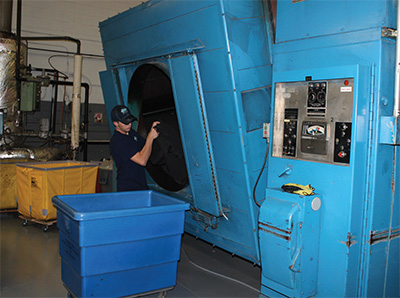Process Optimization for New and Existing Dryers
 Maximizing dryer performance and energy efficiency is critical for industrial laundries. While the industry has benefited from relatively low energy prices in recent years, optimizing the drying process remains essential for three key reasons:
Maximizing dryer performance and energy efficiency is critical for industrial laundries. While the industry has benefited from relatively low energy prices in recent years, optimizing the drying process remains essential for three key reasons:
- Market Trends: Fully drying linens is becoming increasingly common across key market segments: healthcare (80%), hospitality (55%), and food & beverage (40%). This trend is expected to continue as synthetic fabrics, which require specific drying conditions to maintain their integrity, gain popularity.
- Fabric Evolution: Synthetics retain less water after extraction, reducing energy consumption and drying times. However, they are highly sensitive to heat, and improper drying can significantly shorten linen life cycles.
- Future-Proofing: Even with low energy costs, optimizing drying processes helps facilities remain cost-efficient and better prepared for potential energy price fluctuations.
Key Mechanical Considerations
To optimize dryer performance, operators must first address external mechanical factors, whether upgrading existing equipment or installing new dryers.
1. Proper Ductwork for Exhaust and Intake
Improperly sized or installed ductwork is a leading cause of dryer inefficiency and increased energy usage. Poor airflow can also damage linens and create unsafe operating conditions. A simple manometer test can assess exhaust pressure:
- Ideal: 0.5 inches of water column or less
- Critical: Over 1.5 inches (operation should be stopped and airflow corrected)
Fresh air intakes also play a vital role. Facilities that seal garage doors in colder months may notice automatic door closures due to negative pressure. Introducing outside air can help regulate humidity, improving drying efficiency.
2. Proper Gas Sizing
Older dryers may operate at suboptimal gas pressure due to outdated designs, leading to inefficient performance. Ensure that dryers receive the correct gas pressure by consulting the owner’s manual or equipment nameplate, then working with manufacturers and contractors to confirm proper gas volume.
Key Factors in Dryer Performance
Beyond external mechanical elements, optimizing an existing dryer requires attention to internal components that directly affect drying times and energy consumption.
1. Minimize Ambient Air Infusion
Leaks in door seals, poorly designed dryer baskets, or substandard manufacturing tolerances allow ambient air to enter the drying chamber, disrupting the drying process. Modern dryers feature airtight doors and precisely placed seals to ensure air passes through the combustion chamber before reaching linens.
2. Airflow Engineering Improvements
Older dryer designs relied on manual engineering estimates rather than scientific airflow analysis. Today’s dryers use computational fluid dynamics (CFD) to optimize airflow, reducing drying times and energy use.
3. Maintain Combustion Blowers and Filters
In older dryers (10+ years), clogged filters can lead to poor gas-air mixtures, inefficient flames, and even dryer fires. Many modern dryers eliminate this filter, reducing maintenance needs.
4. Check and Replace Seals
All dryers use seals that wear over time. Newer models feature more durable, easily replaceable seals, reducing air leakage and improving efficiency.
5. Keep Blower Wheels Balanced and Clean
Blower wheels facilitate airflow. Over time, lint, dirt, and loose bolts can cause imbalance, reducing efficiency and increasing wear on components. Regular cleaning and belt maintenance prevent performance loss. Some newer designs use lint-shedding wheels to reduce debris buildup.
6. Monitor Dryer Cylinder Cleanliness
Coatings like Teflon or ceramics help keep dryer cylinders clean, but they wear over time. Avoid excessive heat or abrasive cleaning methods to extend their lifespan. New dry-particle removal systems provide fast, effective cylinder cleaning without damage.
7. Maintain Lint Collection Systems
Older dryers primarily used lint collection for air quality compliance. Today’s integrated lint systems are crucial for proper airflow and performance, protecting blower wheels and maintaining dryer efficiency.
Optimizing Burner Performance and Controls
While airflow is a dominant factor, burner efficiency, control systems, and proper operating practices also play a role in dryer performance.
1. Burner Health: Blue is Best
- Good: A blue flame indicates proper combustion.
- Bad: A yellow flame suggests clogged lint, incorrect fuel-air ratios, or the need for burner tuning.
2. Advanced Control Technology
Modern dryers adjust heat application based on linen moisture levels, minimizing fabric damage and shrinkage. This precision control ensures fabrics receive the least amount of heat necessary, improving textile longevity.
3. Proper Loading Practices
Loading a dryer to its stated capacity significantly impacts efficiency. Due to varying fabric densities, operators should fine-tune load weights for different classifications to maximize performance.
Final Thoughts
Drying efficiency is a science that requires careful attention to airflow, mechanical condition, burner performance, and load management. Industrial laundries should work closely with equipment manufacturers to implement best practices and ensure long-term dryer reliability and efficiency.
Need expert advice on optimizing your dryers? Contact GA Braun for tailored solutions to maximize performance and reduce operating costs.
